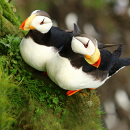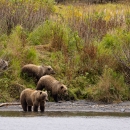States
AlaskaThe Kodiak Archipelago is home to high numbers of breeding seabirds, the majority of which breed on U.S. Fish and Wildlife Service lands administered by Alaska Maritime and Kodiak National Wildlife Refuges. Most species of seabirds are colonial and nest at high densities in a variety of coastal habitats including cliff faces, crevices, and burrows in soft soil at both mainland sites and on offshore islands and rocks. Kodiak and Alaska Maritime Refuges in conjunction with USFWS Migratory Bird Management division have periodically surveyed seabirds throughout the Archipelago.
Designated seabird colony surveys were conducted on Kodiak in 2008-2010 when 86% of the 377 documented colonies in the Archipelago were visited. Due to significant breeding population declines and disappearance of entire colonies of Arctic and Aleutian terns (Sterna paradisaea, Onychoprion aleuticus) in Prince William Sound (1999-2000 surveys) these species were targeted for monitoring on Kodiak Island during colony surveys in 2001-2002, and have remained species we focus on during breeding season surveys.




